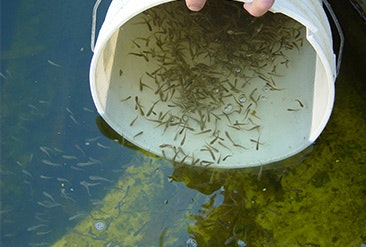Biological Control

Biological control agents of mosquito larvae include predatory fish, predatory aquatic invertebrates, and mosquito pathogens.
Mosquitofish (Gambusia affinis) are ideal control agents for several reasons. They feed primarily at the water’s surface, where larvae can be found. They can tolerate a significant range in water temperature and water quality. They are also easy to handle, transport, stock, and monitor. The use of mosquitofish is a long-term control strategy that works well in artifical water bodies such as ornamental ponds, animal watering troughs, water gardens, fountains, and unmaintained swimming pools.
Mosquito pathogens include an assortment of viruses and bacteria. Examples of bacteria pathogenic to mosquitoes are Bacillus sphaericus (Bs), Bacillus thuringiensis israelensis (Bti), and Saccharopolyspora spinosa (spinosid). These materials are also referred to as biorational products. Bs and Bti, produce proteins that are toxic to most mosquito larvae, while spinosid produces compounds known as spinosysns, which effectively control all larval mosquitoes. Bs can reproduce in natural settings for some time following release. Bti materials the District applies do not contain live organisms, but only spores made up of specific protein molecules. Both Bs and Bti are extremely mosquito specific and do not affect other aquatic life. All three bacteria are naturally occurring soil organisms that are commercially produced as mosquito larvicides.

